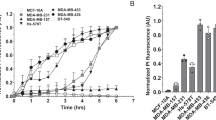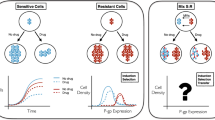Abstract
DEVELOPMENT of cellular resistance to actinomycin D (AD) has been reported in tumour cell populations in vivo1,2 and in vitro3–6. Such cells have a lower capacity than normal to incorporate AD3,6–8, prompting suggestions that the AD-resistant phenotype is determined by changes in plasma membrane function that reduce cellular permeability to this drug. Support for this proposed mechanism of drug resistance has been provided by experiments showing that treatment of AD-resistant cells with membrane-active detergents, to increase plasma membrane permeability, enhances AD uptake by resistant cells and reduces the concentration of AD required to inhibit cell growth8,9. This approach, while instructive, has the disadvantage that the detergent causes significant alteration in cell viability and also impairs cell growth8. We now report a new method for enhancing drug uptake by permeability restriction, drug-resistant cells which uses lipid vesicles as carrier agents to introduce AD directly into cells. As reported elsewhere10,11, negatively-charged lipid vesicles composed of lipids or lipid mixtures that are “fluid” at 37 °C are incorporated into cultured cells by fusion with the cellular plasma membrane. Entrapment of drugs inside such vesicles and subsequent fusion of the vesicles with cells offers a potential method for bypassing the plasma membrane transport barrier to introduce drugs directly into the intracellular compartment. Since vesicles are not cytotoxic10–12, their use as drug carriers allows direct evaluation of the cellular response to the introduced drug, free from the complications8,9,13 associated with the use of detergents. The results presented here indicate that uptake of vesicles containing AD by AD-resistant cells produces inhibition of cellular RNA synthesis and cell growth at AD concentrations that have no effect on cells when added as free drug to the culture medium.
This is a preview of subscription content, access via your institution
Access options
Subscribe to this journal
Receive 51 print issues and online access
$199.00 per year
only $3.90 per issue
Buy this article
- Purchase on Springer Link
- Instant access to full article PDF
Prices may be subject to local taxes which are calculated during checkout
Similar content being viewed by others
References
Kessel, D., and Wodinsky, I., Biochem. Pharmac. 17, 161–164 (1968).
Kessel, D., and Bossmann, H. B., Cancer Res., 30, 2695–2701 (1970).
Goldstein, M. N., Hamm, K., and Amrod, E., Science, 151, 1553–1556 (1966).
Biedler, J. L., and Riehm, H., Cancer Res., 30, 1174–1184 (1970).
Cremisi, C., Sonnenschein, G. E., and Tournier, P., Expl Cell Res., 89, 89–94 (1974).
Langelier, Y., Simrad, R., and Brailovsky, C., Differentiation, 2, 261–267 (1974).
Peterson, R. H. F., O'Neil, J. A., and Biedler, J. L., J. Cell Biol., 63, 773–779 (1974).
Polet, H., J. Pharmac. exp. Ther., 192, 270–279 (1975).
Riehm, H., and Biedler, J. M., Cancer Res., 32, 1195–1200 (1972).
Papahadjopoulos, D., Poste, G., and Mayhew, E., Biochem. Soc. Trans., 3, 606–607 (1975).
Poste, G., and Papahadjopoulos, D., Proc. natn. Acad. Sci. U.S.A. (in the press).
Papahadjopoulos, D., Mayhew, E., Poste, G., Smith, S., and Vail, W. J., Nature, 252, 163–166 (1974).
Yamada, T., Iwanami, Y., and Baba, T., Gann, 54, 171–176 (1963).
Papahadjopoulos, D., Poste, G., and Mayhew, E., Biochim. biophys. Acta, 363, 404–418 (1974).
Poste, G., Papahadjopoulos, D., and Vail, W. J., Methods in Cell Biology (edit. by Prescott, D. M.), 14 (Academic, in the press).
Gregoriadis, G., FEBS Lett., 36, 292–296 (1973).
Colley, R. M., and Ryman, B. E., Biochem. Soc. Trans., 3, 157–159 (1975).
Rahman, Y-E., and Wright, B. J., J. Cell Biol., 65, 112–122 (1975).
deDuve, et al., Biochem. Pharmac., 23, 2495–2531 (1974).
Kessel, D., Biochem. Pharmac., Suppl. 2, 47–50 (1974).
Gregoriadis, G., and Neerunjun, E. D., Biochem. biophys. Res. Commun., 65, 537–544 (1975).
Author information
Authors and Affiliations
Rights and permissions
About this article
Cite this article
POSTE, G., PAPAHADJOPOULOS, D. Drug-containing lipid vesicles render drug-resistant tumour cells sensitive to actinomycin D. Nature 261, 699–701 (1976). https://doi.org/10.1038/261699a0
Received:
Accepted:
Published:
Issue Date:
DOI: https://doi.org/10.1038/261699a0
This article is cited by
-
Flow microfluorometric monitoring of the interaction of lipid vesicles with cells
Histochemistry (1977)
Comments
By submitting a comment you agree to abide by our Terms and Community Guidelines. If you find something abusive or that does not comply with our terms or guidelines please flag it as inappropriate.



